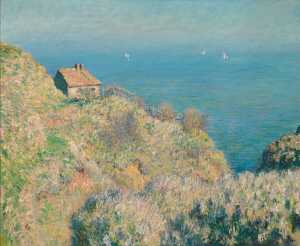Claude Monet moved at a young age from Paris to the Normandy city Le Havre. There he became a pupil of Eugène Boudin. From 1860 to 1862 he was stationed as a military conscript in Algeria. In 1862 he returned to Paris where he became friends with the artists Sisley, Renoir, Manet and Pisarro. He travelled to London in 1870 to escape the Franco-German war. He returned to France in 1871 via the Netherlands, and he settled in Argenteuil near Paris. It was here in 1874 that he painted the work 'Impression, setting sun', which title led to a critic introducing the mocking name of 'Impressionism'. In 1878 Monet moved to the small village of Vétheuil, where he shared a house with the banker Ernest Hoschedé. In the early 1880s he worked a lot on the Normandy coast. In 1883 he moved to Giverny in Normandy, where he designed a garden with water lilies which would prove such an important source of inspiration for his later work.

Claude Monet
Parijs 1840 - Giverny 1926







